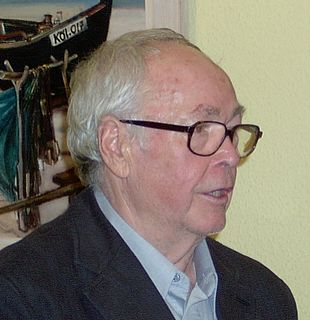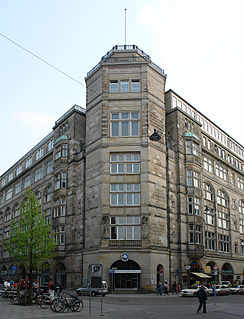Example work
- Cotton exchange Bremen
- Golden Hall in Stockholm City Hall
- Deutscher Brunnen in Istanbul
- Himmelfahrtkirche in Jerusalem
- Oberbaumbrücke in Berlin
Puhl & Wagner was the largest German company for the production of glass mosaics and stained glass. Based in Berlin, the company traded from 1889 to 1969.
Puhl & Wagner was founded in 1889 in Berlin. Commissions from Wilhelm II confirmed the company as the country's leading producer of glass mosaics. By 1904 the company required a new building which was designed by Franz Schwechten. Puhl & Wagner merged in 1914 with the company belonging to Gottfried Heinersdorff who had excellent connections with several contemporary artists. The new company produced stained glass and mosaics. [1]
After the Nazis came to power the company won further commissions and after the war received orders from private businesses. In 1969, as a result of the Berlin Wall, the company stopped trading in 1969. The company archives are now held in public ownership. [1]
Puhl & Wagner is probably best known in Sweden for their mosaics in the Golden Hall of the Stockholm City Hall which was constructed between 1921 and 1923. [2]

Art Nouveau is an international style of art, architecture, and applied art, especially the decorative arts, known in different languages by different names: Jugendstil in German, Stile Liberty in Italian, Modernisme català in Catalan, etc. In English it is also known as the Modern Style. The style was most popular between 1890 and 1910. It was a reaction against the academic art, eclecticism and historicism of 19th century architecture and decoration. It was often inspired by natural forms such as the sinuous curves of plants and flowers. Other characteristics of Art Nouveau were a sense of dynamism and movement, often given by asymmetry or whiplash lines, and the use of modern materials, particularly iron, glass, ceramics and later concrete, to create unusual forms and larger open spaces.

Louis Comfort Tiffany was an American artist and designer who worked in the decorative arts and is best known for his work in stained glass. He is the American artist most associated with the Art Nouveau and Aesthetic movements. He was affiliated with a prestigious collaborative of designers known as the Associated Artists, which included Lockwood de Forest, Candace Wheeler, and Samuel Colman. Tiffany designed stained glass windows and lamps, glass mosaics, blown glass, ceramics, jewelry, enamels, and metalwork. He was the first design director at his family company, Tiffany & Co., founded by his father Charles Lewis Tiffany.

The Palau de la Música Catalana is a concert hall in Barcelona, Catalonia, Spain. Designed in the Catalan modernista style by the architect Lluís Domènech i Montaner, it was built between 1905 and 1908 for the Orfeó Català, a choral society founded in 1891 that was a leading force in the Catalan cultural movement that came to be known as the Renaixença. It was inaugurated on 9 February 1908.

The Stockholm City Hall is the building of the Municipal Council for the City of Stockholm in Sweden. It stands on the eastern tip of Kungsholmen island, next to Riddarfjärden's northern shore and facing the islands of Riddarholmen and Södermalm. It houses offices and conference rooms as well as ceremonial halls, and the luxury restaurant Stadshuskällaren. It is the venue of the Nobel Prize banquet and is one of Stockholm's major tourist attractions.

The Kaiser Wilhelm Memorial Church is a Protestant church affiliated with the Evangelical Church in Berlin, Brandenburg and Silesian Upper Lusatia, a regional body of the Evangelical Church in Germany. It is located in Berlin on the Kurfürstendamm in the centre of the Breitscheidplatz.
The year 1921 in architecture involved some significant architectural events and new buildings.

The Victory Column is a monument in Berlin, Germany. Designed by Heinrich Strack after 1864 to commemorate the Prussian victory in the Second Schleswig War, by the time it was inaugurated on 2 September 1873, Prussia had also defeated Austria and its German allies in the Austro-Prussian War (1866) and France in the Franco-Prussian War (1870–71), giving the statue a new purpose. Different from the original plans, these later victories in the so-called unification wars inspired the addition of the bronze sculpture of Victoria, the Roman goddess of victory, 8.3 metres (27 ft) high and weighing 35 tonnes, designed by Friedrich Drake. Berliners have given the statue the nickname Goldelse, meaning something like "Golden Lizzy".

Anton Alexander von Werner was a German painter known for his history paintings of notable political and military events in the Kingdom of Prussia. One of the most famous painters of his time, he is regarded a main protagonist of the Wilhelmine Period.

Charles Crodel was a German painter and stained glass artist.

Conrad Schmitt Studios is an architectural arts studio located in New Berlin, Wisconsin. It provides ecclesiastical art, stained glass artistry, art glass, decorative painting, mosaics, murals and sculptural arts. The studio specializes in restoration services for buildings of architectural, historical and religious significance. Founded in 1889 by German-American artist Conrad Schmitt, the company is one of the oldest and largest glass studios in the United States.

Gabriel Loire was a French stained glass artist of the twentieth century whose extensive works, portraying various persons or historical scenes, appear in many venues around the world. He founded the Loire Studio in Chartres, France which continues to produce stained glass windows. Loire was a leader in the modern use of "slab glass", which is much thicker and stronger than the stained glass technique of the Middle Ages. The figures in his windows are mostly Impressionistic in style.

Walter Womacka was a German Socialist Realist artist.
Willet Hauser Architectural Glass, Inc is a North American stained glass firm located in Winona, Minnesota that specializes in the design, fabrication, preservation and restoration of leaded stained glass and faceted glass windows.

Brian Clarke is a British architectural artist, painter and printmaker, known for his large-scale stained glass and mosaic projects, abstract and symbolist canvases, and collaborations with major figures in Modern and contemporary architecture.

The Bremen Cotton Exchange was built in 1902 on the market square in Bremen, Germany, to house the offices of the city's cotton exchange founded in 1872. Johann Poppe's Neo-Renaissance facades and carefully finished interiors can still be seen today.

The Golden Hall is a banqueting hall in Stockholm City Hall. Measuring 44-metre (144 ft) in length, it received its name when its walls were decorated by mosaics created by the artist Einar Forseth on a proposal by the City Hall architect Ragnar Östberg. The hall is best known as the location of the ball after the annual Nobel Banquet in the City Hall's Blue Hall.

Carl Einar Andreas Forseth (1892–1988) was a Swedish artist, remembered above all for his mosaics in the Golden Hall in Stockholm City Hall completed in 1923.
Puhl is a surname. Notable people with the name include:

Hans Wagner was a German sculptor and painter.
Art Nouveau temples are churches, chapels, synagogues, and mosques built in the style known as Art Nouveau in French and English languages, Jugendstil in Germany and Nordic countries, Secessionsstil in countries of former Austro-Hungary, Modernisme in Catalan or Modern in Russian. As National Romantic style is also referred to Art Nouveau, churches of that style are also listed here, as well as some temples not of pure Art Nouveau style but with distinctive Art Nouveau features.
This article is partially based on material from the German Wikipedia
| Wikimedia Commons has media related to Puhl und Wagner . |